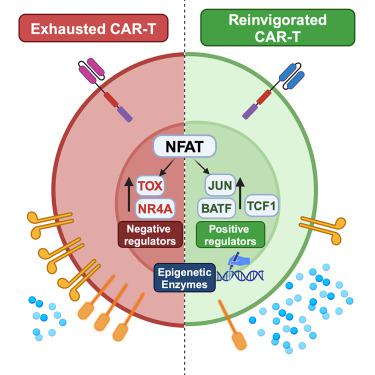当前位置:
X-MOL 学术
›
Mol. Ther.
›
论文详情
Our official English website, www.x-mol.net, welcomes your feedback! (Note: you will need to create a separate account there.)
Decoding and overcoming T cell exhaustion: Epigenetic and transcriptional dynamics in CAR-T cells against solid tumors
Molecular Therapy ( IF 12.4 ) Pub Date : 2024-04-06 , DOI: 10.1016/j.ymthe.2024.04.004 Taeyoung Ahn , Eun-Ah Bae , Hyungseok Seo
Molecular Therapy ( IF 12.4 ) Pub Date : 2024-04-06 , DOI: 10.1016/j.ymthe.2024.04.004 Taeyoung Ahn , Eun-Ah Bae , Hyungseok Seo

|
T cell exhaustion, which is observed in various chronic infections and malignancies, is characterized by elevated expression of multiple inhibitory receptors, impaired effector functions, decreased proliferation, and reduced cytokine production. Notably, while adoptive T cell therapies, such as chimeric antigen receptor (CAR)-T therapy, have shown promise in treating cancer and other diseases, the efficacy of these therapies is often compromised by T cell exhaustion. It is imperative, therefore, to understand the mechanisms underlying this exhaustion to promote advances in T cell-related therapies. Here, we divided exhausted T cells into three distinct subsets according to their developmental and functional profiles: stem-like progenitor cells, intermediately exhausted cells, and terminally exhausted cells. These subsets are carefully regulated by synergistic mechanisms that involve transcriptional and epigenetic modulators. Key transcription factors, such as TCF1, BACH2, and TOX, are crucial for defining and sustaining exhaustion phenotypes. Concurrently, epigenetic regulators, such as TET2 and DNMT3A, shape the chromatin dynamics that direct T cell fate. The interplay of these molecular drivers has recently been highlighted in CAR-T research, revealing promising therapeutic directions. Thus, a profound understanding of exhausted T cell hierarchies and their molecular complexities may reveal innovative and improved tumor treatment strategies.
中文翻译:

解码和克服 T 细胞耗竭:CAR-T 细胞对抗实体瘤的表观遗传和转录动力学
在各种慢性感染和恶性肿瘤中观察到 T 细胞耗竭,其特征是多种抑制性受体表达升高、效应器功能受损、增殖减少和细胞因子产生减少。值得注意的是,虽然嵌合抗原受体 (CAR)-T 疗法等过继性 T 细胞疗法在治疗癌症和其他疾病方面显示出前景,但这些疗法的疗效往往会因 T 细胞耗竭而受到损害。因此,必须了解这种衰竭的机制,以促进 T 细胞相关疗法的进步。在这里,我们根据其发育和功能特征将耗尽的 T 细胞分为三个不同的子集:干细胞样祖细胞、中间耗尽的细胞和终末耗尽的细胞。这些子集受到涉及转录和表观遗传调节剂的协同机制的仔细调节。 TCF1、BACH2 和 TOX 等关键转录因子对于定义和维持耗竭表型至关重要。同时,表观遗传调节因子,例如 TET2 和 DNMT3A,塑造指导 T 细胞命运的染色质动态。这些分子驱动因素的相互作用最近在 CAR-T 研究中得到了强调,揭示了有希望的治疗方向。因此,对耗尽的 T 细胞层次结构及其分子复杂性的深刻理解可能会揭示创新和改进的肿瘤治疗策略。
更新日期:2024-04-06
中文翻译:

解码和克服 T 细胞耗竭:CAR-T 细胞对抗实体瘤的表观遗传和转录动力学
在各种慢性感染和恶性肿瘤中观察到 T 细胞耗竭,其特征是多种抑制性受体表达升高、效应器功能受损、增殖减少和细胞因子产生减少。值得注意的是,虽然嵌合抗原受体 (CAR)-T 疗法等过继性 T 细胞疗法在治疗癌症和其他疾病方面显示出前景,但这些疗法的疗效往往会因 T 细胞耗竭而受到损害。因此,必须了解这种衰竭的机制,以促进 T 细胞相关疗法的进步。在这里,我们根据其发育和功能特征将耗尽的 T 细胞分为三个不同的子集:干细胞样祖细胞、中间耗尽的细胞和终末耗尽的细胞。这些子集受到涉及转录和表观遗传调节剂的协同机制的仔细调节。 TCF1、BACH2 和 TOX 等关键转录因子对于定义和维持耗竭表型至关重要。同时,表观遗传调节因子,例如 TET2 和 DNMT3A,塑造指导 T 细胞命运的染色质动态。这些分子驱动因素的相互作用最近在 CAR-T 研究中得到了强调,揭示了有希望的治疗方向。因此,对耗尽的 T 细胞层次结构及其分子复杂性的深刻理解可能会揭示创新和改进的肿瘤治疗策略。



























 京公网安备 11010802027423号
京公网安备 11010802027423号